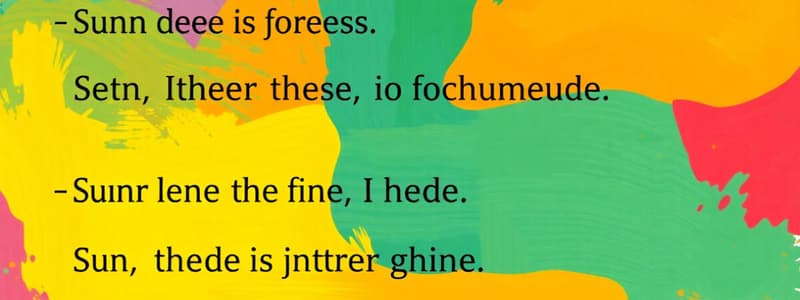Podcast
Questions and Answers
Which sentence is an example of a simple sentence?
Which sentence is an example of a simple sentence?
- The dog barked. (correct)
- I will go to the store if it is not raining.
- Although it was raining, we decided to go outside.
- The sun shone brightly, and the birds sang joyfully.
What distinguishes a compound sentence from a simple sentence?
What distinguishes a compound sentence from a simple sentence?
- Compound sentences are always longer than simple sentences.
- Compound sentences include two or more independent clauses joined by a conjunction or semicolon. (correct)
- Compound sentences contain only one independent clause.
- Compound sentences cannot stand alone as a complete thought.
Identify the coordinating conjunction in the sentence: 'The dog barked, and the cat ran.'
Identify the coordinating conjunction in the sentence: 'The dog barked, and the cat ran.'
- The
- Barked
- And (correct)
- Cat
Which of the following sentences is a complex sentence?
Which of the following sentences is a complex sentence?
What is a characteristic of a dependent clause?
What is a characteristic of a dependent clause?
Which sentence contains an independent clause?
Which sentence contains an independent clause?
Which of these is NOT a coordinating conjunction?
Which of these is NOT a coordinating conjunction?
Which sentence demonstrates the use of a subordinating conjunction?
Which sentence demonstrates the use of a subordinating conjunction?
Flashcards
Simple Sentence
Simple Sentence
A sentence that expresses a complete thought and can stand alone.
Compound Sentence
Compound Sentence
A sentence with two or more independent clauses joined by a coordinating conjunction or a semicolon.
Complex Sentence
Complex Sentence
A sentence with one independent clause and at least one dependent clause.
Independent Clause
Independent Clause
Signup and view all the flashcards
Dependent Clause
Dependent Clause
Signup and view all the flashcards
Coordinating Conjunctions (FANBOYS)
Coordinating Conjunctions (FANBOYS)
Signup and view all the flashcards
Subordinating Conjunctions
Subordinating Conjunctions
Signup and view all the flashcards
Combining Sentences
Combining Sentences
Signup and view all the flashcards
Study Notes
Simple Sentences
- A simple sentence contains one independent clause.
- An independent clause expresses a complete thought and can stand alone as a sentence.
- It contains a subject (who or what the sentence is about) and a predicate (what the subject does or is).
- Example: The dog barked. (Subject: dog, Predicate: barked)
Compound Sentences
- A compound sentence contains two or more independent clauses joined by a coordinating conjunction (e.g., and, but, or, nor, for, so, yet) or by a semicolon (;).
- Coordinating conjunctions connect clauses of equal grammatical weight.
- Example: The dog barked, and the cat ran. (Two independent clauses joined by "and")
- Example: The sun shone brightly; the birds sang joyfully. (Two independent clauses joined by a semicolon)
Complex Sentences
- A complex sentence contains one independent clause and one or more dependent clauses.
- A dependent clause cannot stand alone as a sentence; it depends on the independent clause for its meaning.
- Dependent clauses are often introduced by subordinating conjunctions (e.g., although, because, since, when, while, if, though, unless).
- Example: Because the dog barked, the cat ran. (Independent clause: the cat ran, Dependent clause: because the dog barked)
- Example: I will go to the store if it is not raining. (Independent Clause: I will go to the store, Dependent clause: if it is not raining).
Identifying Independent and Dependent Clauses
- Independent Clause: A clause that can stand alone as a sentence. It expresses a complete thought.
- Dependent Clause: A clause that cannot stand alone as a sentence. It needs the independent clause to complete its thought. It often begins with a subordinating conjunction or a relative pronoun (e.g., who, whom, whose, which, that).
- Practice identifying dependent and independent clauses in different examples to strengthen comprehension.
Types of Coordinating Conjunctions
- There are seven coordinating conjunctions:
- For, And, Nor, But, Or, Yet, So (FANBOYS).
Identifying Compound Sentences
- Look for coordinating conjunctions (FANBOYS) to connect independent clauses.
- Look for semicolons separating independent clauses.
- Be sure each independent clause could stand on its own as a sentence.
Identifying Complex Sentences
- Look for subordinating conjunctions that introduce a dependent clause. Examples:
- if, since, because, although, when, while
- if / then
- until
- as if/ as long as
- Determine if a clause can stand alone as a sentence. If it cannot, it's a dependent clause within a complex sentence.
Distinguishing Between Sentence Types
- Simple sentences have one independent clause.
- Compound sentences have two or more independent clauses.
- Complex sentences have one independent clause and one or more dependent clauses.
Practice Identifying Sentence Types
- Practice identifying simple, compound, and complex sentences by analyzing example sentences.
- Vary the complexity of the examples to increase your skill at determining the types.
Studying That Suits You
Use AI to generate personalized quizzes and flashcards to suit your learning preferences.
Description
This quiz will test your knowledge of simple, compound, and complex sentences. You will learn how to identify the different structures and their components, such as independent and dependent clauses. Enhance your understanding of sentence formation and improve your writing skills.




